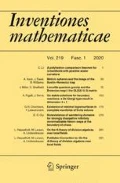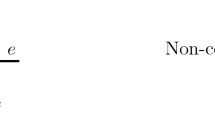Abstract
This paper initiates the study of rigidity for immersed, totally geodesic planes in hyperbolic 3-manifolds M of infinite volume. In the case of an acylindrical 3-manifold whose convex core has totally geodesic boundary, we show that the closure of any immersed geodesic plane is a properly immersed submanifold of M. On the other hand, we show that rigidity fails for quasifuchsian manifolds.



Similar content being viewed by others
References
Dal’bo, F.: Topologie du feuilletage fortement stable. Ann. Inst. Fourier 50, 981–993 (2000)
Dani, S.G., Margulis, G.A.: Limit distributions of orbits of unipotent flows and values of quadratic forms. In: I. M. Gelfand Seminar, vol. 16 of Adv. Soviet Math., pp. 91–137. American Mathematical Society, USA (1993)
Eberlein, P.: Geodesic flows on negatively curved manifolds. I. Ann. Math. 95, 492–510 (1972)
Epstein, D.B.A., Marden, A.: Convex hulls in hyperbolic space, a theorem of Sullivan, and measured pleated surfaces. In: Analytical and Geometric Aspects of Hyperbolic Space, pp. 113–254. Cambridge University Press, Cambridge (1987)
Einsiedler, M.L. et al. (ed.): Homogeneous flows, moduli spaces and arithmetic, vol. 10 of Clay Mathematics Proceedings. American Mathematical Society, USA (2010)
Ferte, D.: Flot horosphérique des repères sur les variétés hyperboliques de dimension 3 et spectre des groupes kleiniens. Bull. Braz. Math. Soc. 33, 99–123 (2002)
Hedlund, G.A.: Fuchsian groups and transitive horocycles. Duke Math. J. 2, 530–542 (1936)
Kamishima, Y.: Tan, Ser P: Deformation spaces on geometric structures. In: Matsumoto, Y., Morita, S. (eds.) Aspects of Low Dimensional Manifolds, pp. 263–300. Math. Soc. of Japan by Kinokuniya Co., Japan (1992)
Maclachlan, C., Reid, A.W.: Commensurability classes of arithmetic Kleinian groups and their Fuchsian subgroups. Math. Proc. Camb. Philos. Soc. 102, 251–257 (1987)
Maclachlan, C., Reid, A.W.: The Arithmetic of Hyperbolic 3-Manifolds. Springer, New York (2003)
Margulis, G.A.: Indefinite quadratic forms and unipotent flows on homogeneous spaces. In: Dynamical systems and ergodic theory (Warsaw, 1986), vol. 23. Banach Center Publcations, Japan (1989)
Margulis, G.A.: Dynamical and ergodic properties of subgroup actions on homogeneous spaces with applications to number theory. In: Proceedings of the International Congress of Mathematicians (Kyoto, 1990), pp. 193–215. Springer, New York (1991)
Matsuzaki, K., Taniguchi, M.: Hyperbolic Manifolds and Kleinian Groups. Oxford University Press, Oxford (1998)
McMullen, C.: Iteration on Teichmüller space. Invent. Math. 99, 425–454 (1990)
McMullen, C.: Complex earthquakes and Teichmüller theory. J. Am. Math. Soc. 11, 283–320 (1998)
McMullen, C.: Teichmüller geodesics of infinite complexity. Acta Math. 191, 191–223 (2003)
McMullen, C., Mohammadi, A., Oh, H.: Horocycles in hyperbolic 3-manifolds. Geom. Funct. Anal. 26, 961–973 (2016)
Payne, T.L.: Closures of totally geodesic immersions into locally symmetric spaces of noncompact type. Proc. Am. Math. Soc. 127, 829–833 (1999)
Prasad, G., Rapinchuk, A.S.: Existence of irreducible \({\mathbb{R}}\)-regular elements in Zariski-dense subgroups. Math. Res. Lett. 10, 21–32 (2003)
Ratcliffe, J.G.: Foundations of Hyperbolic Manifolds. Springer, New York (1994)
Ratner, M.: On Raghunathan’s measure conjecture. Ann. Math. 134, 545–607 (1991)
Ratner, M.: Raghunathan’s topological conjecture and distributions of unipotent flows. Duke Math. J. 63, 235–280 (1991)
Ratner, M.: Interactions between ergodic theory, Lie groups and number theory. In: Proceedings of the International Congress of Mathematicians (Zürich, 1994), pp. 156–182. Birkhaüser, Basel (1995)
Reid, A.W.: Totally geodesic surfaces in hyperbolic 3-manifolds. Proc. Edinb. Math. Soc. 34, 77–88 (1991)
Shah, N.A.: Closures of totally geodesic immersions in manifolds of constant negative curvature. In: Group Theory from a Geometrical Viewpoint (Trieste, 1990), pp. 718–732. World Scientific, Singapore (1991)
Sullivan, D.: Related aspects of positivity: \(\lambda \)–potential theory on manifolds, lowest eigenstates, Hausdorff geometry, renormalized Markoff processes. In: Aspects of mathematics and its applications, vol. 34, pp. 747–779. North–Holland (1986)
Thurston, W.P.: Geometry and Topology of Three-Manifolds. Lecture Notes. Princeton University, Princeton (1979)
Thurston, W.P.: Hyperbolic structures on 3-manifolds I: Deformations of acylindrical manifolds. Ann. Math. 124, 203–246 (1986)
Whyburn, G.T.: Topological characterization of the Sierpiński curve. Fund. Math. 45, 320–324 (1958)
Winter, D.: Mixing of frame flow for rank one locally symmetric spaces and measure classification. Israel J. Math. 210, 467–507 (2015)
Author information
Authors and Affiliations
Additional information
Research supported in part by the Alfred P. Sloan Foundation (A.M.) and the NSF.
Appendices
Appendix A: Quasifuchsian groups
In this section we show that for a quasifuchsian group \(\Gamma \), the closure of a geodesic plane in \(M = \Gamma \backslash {\mathbb H}^3\) passing through the convex core can be rather wild. The case of a Fuchsian group was treated in the Introduction, and we will show the same phenomena persists under a small bending deformation.
Bending. Let \(\Sigma _0 = \Gamma _0 \backslash {\mathbb H}^2\) be a closed hyperbolic surface of genus \(g \ge 2\). We can identify \(\Sigma _0\) with the convex core of the 3-manifold \(M_0= \Gamma _0 \backslash {\mathbb H}^3\), which can be written as
in cylindrical coordinates. Here the first coordinate is given by the nearest-point projection \(\pi : M_0 \rightarrow \Sigma _0\), and the second is given by the signed distance from \(\Sigma _0\).
Let \(\beta \subset \Sigma _0\) be a simple closed curve. Then for all angles \(\theta \) sufficiently small, there is a quasifuchsian manifold \(M_\theta = \Gamma _\theta \backslash {\mathbb H}^3\) and a path isometry
such that \(\Sigma _\theta \) is bent with a dihedral angle of \(\theta \) along the image of \(\beta \), and otherwise totally geodesic. The manifold \(M_\theta \) is unique up to isometry. See e.g. [27, Ch. 8], [4, 8, 15] for this construction.
Choose r sufficiently small that \(\beta \) has an embedded annular collar neighborhood \(B_r\) of width 2r. Removing this collar, we obtain a surface with boundary
and a closed submanifold
There is a unique extension of \(j_\theta | \Sigma _0(r)\) to an orientation-preserving isometric immersion
which sends geodesics normal to \(\Sigma _0(r)\) to geodesics normal to \(\Sigma _\theta (r) = j_\theta (\Sigma _0(r))\).
Proposition A.1
Assume \(M_\theta \) is a quasifuchsian manifold, and \(\sin (|\theta |/2) < \tanh (r)\). Then the map \(J_\theta : M_0(r) \rightarrow M_\theta \) is a proper, isometric embedding.
Sketch of the proof
Qualitatively, the statement above is nearly immediate from the divergence of geodesics normal to \(\Sigma _0\) (see Fig. 4). The extreme case \(\sin (\theta /2) = \tanh (r)\) corresponds to a hyperbolic right triangle with base of length r and one ideal vertex; its internal angles are \((0,\pi ,\pi -\theta /2)\). \(\square \)
Planes in quasifuchsian manifolds. Now let \(\gamma \subset \Sigma _0\) be an immersed geodesic such that \({\overline{\gamma }}\) is disjoint from \(\beta \). Then we can also choose r sufficiently small that \({\overline{\gamma }}\) lies in \(\Sigma _0(r)\). As discussed in Sect. 1, the locus \(P = \gamma \times {\mathbb R}\subset M_0\) is an immersed geodesic plane with
But in fact we have \({\overline{P}}\subset M_0(r)\). Thus \(P_\theta = J_\theta (P)\) is an immersed geodesic plane in \(M_\theta \). By Proposition A.1., for all \(\theta \) sufficiently small, \(J_\theta \) maps a neighborhood of \({\overline{P}}\) isometrically to a neighborhood of \({\overline{P}}_\theta \). This shows:
Corollary A.2
For all \(\theta \) sufficiently small, the quasifuchsian manifold \(M_\theta \) contains an immersed geodesic plane \(P_\theta \), passing through its convex core, such
As noted in Sect. 1, the closure of a geodesic can be rather wild, and the same is true for geodesics with \({\overline{\gamma }}\) disjoint from \(\beta \). In particular, the closure of \(P_\theta \) need not be a submanifold of \(M_\theta \), so we have no analogue of Corollary 1.2.
Appendix B: Bounded geodesic planes
In this section we record a rigidity theorem for bounded geodesic planes in an arbitrary hyperbolic 3-manifold. Shah’s theorem on geodesic planes in a compact hyperbolic 3-manifold [25] follows as a special case.
Theorem B.1
Let \(P \subset M\) be a bounded geodesic plane in an arbitrary hyperbolic 3-manifold \(M = \Gamma \backslash {\mathbb H}^3\). Then either:
-
P is a compact, immersed hyperbolic surface; or
-
M is compact, and \(\overline{P} = M\). More precisely, frames tangent to P are dense in \({{\text {F}}}M\).
Proof
The proof will follow the same lines as the proof in Sect. 9 above.
Let \(\Lambda \subset S^2\) be the limit set of \(\Gamma \), and let \(C \subset S^2\) be a circle corresponding to a lift of P to the universal cover of M. To prove the theorem, we must show that \(\Gamma C \subset {{\mathcal {C}}}\) is either closed or dense. Note we have \(C \subset \Lambda \), because P is bounded in M. Thus every circle D in \(\overline{\Gamma C}\) is also contained in \(\Lambda \).
Assume \(\Gamma C\) is not closed. We will show that \(\overline{\Gamma C} = {{\mathcal {C}}}_\Lambda \).
Since \(\Gamma C\) is not closed, \(\Gamma \) is Zariski dense in G, and there is limit set on both sides of C. (Otherwise C would be the boundary of a component of \(\Omega = S^2-\Lambda \), and hence \(\Gamma C\) would be discrete.)
If \(\Gamma D\) is closed for some \(D \in \overline{\Gamma C}\), then \(\overline{\Gamma C } = {{\mathcal {C}}}_\Lambda \) by Theorems 5.1 and 6.2. So we may assume that C is an exotic circle, i.e. \(\overline{\Gamma D} \ne \Gamma D\) for all \(D \in \overline{\Gamma C}\). Then the corresponding compact, H-invariant set \(X \subset {{\text {F}}}M\) contains no closed H-orbit.
Since P is bounded, and C is contained in \(\Lambda \), X is a compact subset of the renormalized frame bundle \({{\text {RF}}}M\).
The argument of Sect. 9 now goes through verbatim, to show that \(\overline{\Gamma C} = {{\mathcal {C}}}_\Lambda \). Indeed, the argument is somewhat simpler: since \(X \subset {{\text {RF}}}M\), we have \(Y^* = Y\), and hence there is no need to consider thick sets (i.e. we can take \(T_n = U\) when applying Theorems 8.1 and 8.2).
To complete the proof, note that every circle in \(\overline{\Gamma C}\) is contained in the limit set. Thus \(\overline{\Gamma C} = {{\mathcal {C}}}_\Lambda \) implies \(\Lambda = S^2\) and \(\overline{\Gamma C} = {{\mathcal {C}}}\). Consequently frames tangent to P are dense in \({{\text {F}}}M\); and since P is bounded, M is compact. \(\square \)
Using Theorem 11.1, we obtain the following analogue of Corollary 11.2:
Corollary B.2
Let \(K \subset M\) be a compact subset of a hyperbolic 3-manifold. Then either:
-
The set of compact geodesic surfaces in M contained in K is finite; or
-
Compact geodesic surfaces are dense in M, and M is compact.
Remarks
One could also deduce these results from Ratner’s works [21, 22], using [2, Thm. 1] or modifying [22, Thm 2.1] to handle the case where \(\Gamma \) is not a lattice.
Rights and permissions
About this article
Cite this article
McMullen, C.T., Mohammadi, A. & Oh, H. Geodesic planes in hyperbolic 3-manifolds. Invent. math. 209, 425–461 (2017). https://doi.org/10.1007/s00222-016-0711-3
Received:
Accepted:
Published:
Issue Date:
DOI: https://doi.org/10.1007/s00222-016-0711-3




